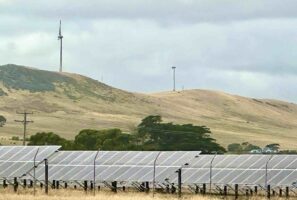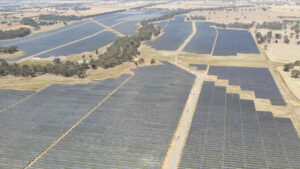After a flurry of coverage of UK Prime Minister Boris Johnson’s “ten point” plan to act on climate change, mostly accompanied by bemusement that a conservative government could act so aggressively on climate, it’s worth pausing to consider exactly where it sits on the spectrum of ambition. The plan comprises of a broad mix of policy concepts, including offshore wind, hydrogen, electric vehicles, new nuclear plants, public transport, zero emissions aviation and shipping and carbon capture and storage.
As part of the UK’s 2050 net zero ambitions, a five-year carbon budget guides short-term policy making. While the UK is projected to scrape in to its current five-year block (carbon budget 3, CB3), it’s going to miss CB4 and badly miss CB5. There is a gap. Those projections are published by the UK government Department for Business, Energy and Industrial Strategy (BEIS). This situation is not unlike Australia’s own Department of Industry, Science, Energy and Resources (DISER), and their projections that Australia will miss its 2030 Paris targets.
As Carbon Brief’s Dr Simon Evans points out on Twitter, the Johnson government’s big new plan chips away at this gap, but does not close it. “Adding [the emissions reductions numbers] up, it looks like the new measures would only close 55% of the gap to meeting UK’s 4th/5th carbon budgets…even before thinking about net zero ambition”. Johnson’s plan is, simultaneously, quite a significant step in the right direction while also not being quite far enough of a step to get to where’s needed to put the country on track for its climate targets. What is up next is an incredible amount of hard work, with each sector of climate action coming packaged with its own unique challenges to scale up and expand ambition.
A clear example is the scale-up in offshore wind required under the Johnson government’s plan. Putting aside the problem of ignoring onshore wind and all the community and regional benefits that would flow from this, the growth of renewables in the UK requires some clear policy interventions from the government that are currently lacking. The 40 gigawatt 2030 target will require significant government intervention, writes UK-based Aurora Energy. “Through the increasing level of subsidised offshore wind in the system, these factors combine to represent larger Government intervention in the power markets and reduce the amount of capacity which is exposed to purely market forces”.
 Could Australia ever find itself in a position where it’s taking tentative first steps towards actually implementing a net zero by 2050 plan from a conservative government? Many elements of Johnson’s plan, such as deployment of renewables, big changes in transport like electric vehicles and incentives for public transport would be clearly impossible under the current government, but the pressure to establish – at the very first step – a 2050 target will grow immensely before COP26 in Glasgow next year. That this conference will be hosted in a country led by an anglophone conservative government with many similarities to Australia only adds to the pressure.
Could Australia ever find itself in a position where it’s taking tentative first steps towards actually implementing a net zero by 2050 plan from a conservative government? Many elements of Johnson’s plan, such as deployment of renewables, big changes in transport like electric vehicles and incentives for public transport would be clearly impossible under the current government, but the pressure to establish – at the very first step – a 2050 target will grow immensely before COP26 in Glasgow next year. That this conference will be hosted in a country led by an anglophone conservative government with many similarities to Australia only adds to the pressure.
In fact, Johnson’s ‘ten point’ plan isn’t all that far from The Morrison government’s “technology roadmap”, in terms of pure spirit. Both are highly technocratic, both focus heavily on industry and business (Johnson’s “Green industrial revolution”), and both are insufficient to hit climate targets. The difference here is in magnitudes of ambition rather than the heart of the policy. There is a rising voice for conservative climate action in Australia, with groups like the Coalition for Conservation trying hard to act as a unifying voice for conservatives interested in the types of climate action tuned to their interests – business friendly, technology-focused and lucrative. State governments like New South Wales and South Australia have stepped into the fray too, keenly putting forward relatively ambitious climate plans. So is the time right for Australia’s federal government to quietly pivot into a Johnson-style technology-focused climate ambition?
I actually don’t think this will happen, in 2021. The major limiting factor here is totally unrelated to domestic emissions and net zero plans. The UK’s position as a major supplier of coal to the world has collapsed, while Australia’s production of coal has exploded. Australia’s gas exports are sky-rocketing, too. Both contribute substantially to domestic emissions, but more importantly, both would prefer to avoid the spectre of domestic decarbonisation lest it encourage Australia’s fossil fuel customers to do the same. 
Australia’s fossil fuel lobby holds notorious and globally recognised sway over the country’s decarbonisation and climate policies. Until there is some new limitation on that level of corporate influence on policy, or until the industry itself winds down (perhaps rapidly, due to other countries ditching Australian coal), it doesn’t matter too much what the intentions of the government are. Johnson will probably keep chipping away at this, with the backlash to his ten point plan being somewhat muted. And Morrison, Taylor and team will go to COP26 with their chins up and their heads held high, representing climate harm and inaction like no other country in the world – with no net zero by 2050 target, unwilling to risk the ire of the country’s incredibly powerful fossil fuel industry, and happy to cop two weeks of embarrassment if it means keeping those friends close.










